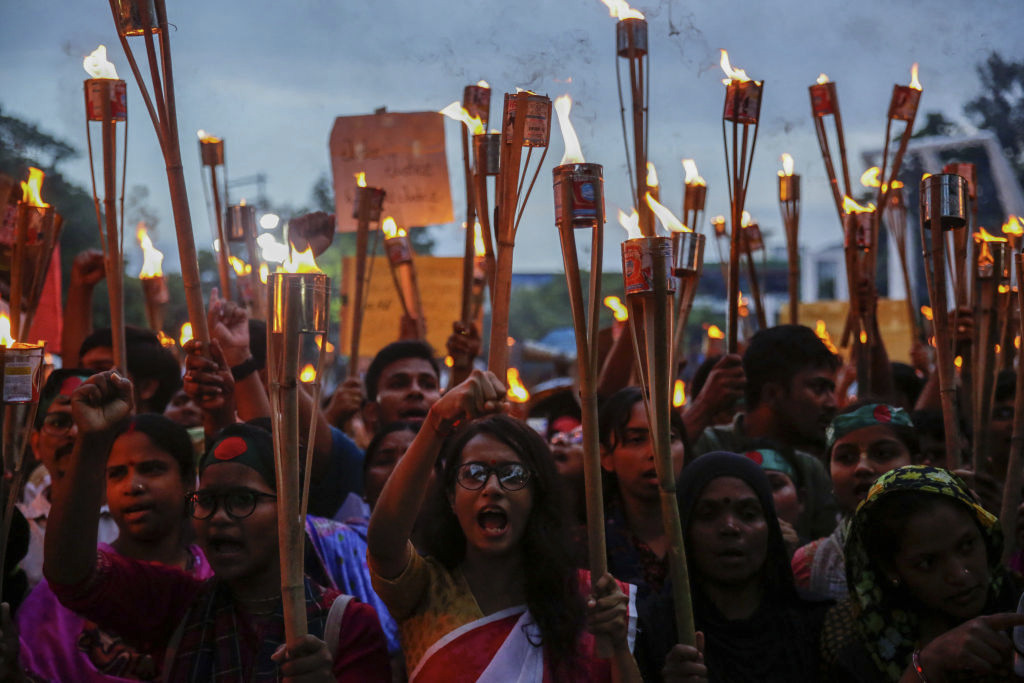 Od czasu upadku w sierpniu rządu Ligi Awami pod przywództwem Sheikh Hasiny świat był świadkiem pełnej islamizacji i talibanizacji Bangladeszu. Piątego listopada społeczność hinduska została zaatakowana przez policję i wojsko w Chittagong, drugim co do wielkości mieście w Bangladeszu. Na zdjęciu: członkowie mniejszości religijnych Bangladeszu protestują w Dhakce przeciwko atakom, grabieżom, wandalizmowi i podpaleniom świątyń w całym kraju. (Zdjęcie: Mehedi Hasan/Middle East Images via AFP)
Od czasu upadku w sierpniu rządu Ligi Awami pod przywództwem Sheikh Hasiny świat był świadkiem pełnej islamizacji i talibanizacji Bangladeszu. Piątego listopada społeczność hinduska została zaatakowana przez policję i wojsko w Chittagong, drugim co do wielkości mieście w Bangladeszu. Na zdjęciu: członkowie mniejszości religijnych Bangladeszu protestują w Dhakce przeciwko atakom, grabieżom, wandalizmowi i podpaleniom świątyń w całym kraju. (Zdjęcie: Mehedi Hasan/Middle East Images via AFP)
 Talibanizacja Bangladeszu: “Kampania ludobójcza przeciwko hinduskiej mniejszości”. Gdzie jest Mohammad Junus?
Talibanizacja Bangladeszu: “Kampania ludobójcza przeciwko hinduskiej mniejszości”. Gdzie jest Mohammad Junus?
Uzay Bulut
Tłumaczenie: Andrzej Koraszewsk
Przemoc islamistów wobec mniejszości, w tym hinduistów i chrześcijan, trwa od czasu brutalnego odsunięcia od władzy świeckiej premier Bangladeszu Sheikh Hasiny 5 sierpnia 2024 r.. Osoby niebędące muzułmanami są narażone na zwiększone ryzyko w związku z trwającym kryzysem politycznym i społecznym.
Piątego listopada społeczność hinduska została zaatakowana przez policję i wojsko w Chittagong, drugim co do wielkości mieście w Bangladeszu. Filmy zamieszczone przez serwis informacyjny OpIndia pokazują policjantów i żołnierzy polujących na Hindusów. Filmy pokazują również, jak organy ścigania celowo niszczą kamery przemysłowe.
O atakach poinformowało także wiele kont na Twitterze: Amy Mek napisała:
“Świat milczy, biernie przyglądając się ludobójstwu Hindusów w Bangladeszu.
“Trump już wydał ostrzeżenie dla Bangladeszu, wzywając rząd do zaprzestania ataków na Hindusów — przypomnienie, że do rozwiązania tego kryzysu potrzebne jest silne przywództwo”.
Gazeta “India Today” pisze:
“Hindusi ponownie na celowniku w #Bangladeszu. Tym razem w Chittagong. Czy administracja kierowana przez laureata Nagrody Nobla, prof. Muhammada Junusa, nie jest w stanie lub nie chce pomóc Hindusom?”
Chrześcijanie w Bangladeszu również są brutalnie atakowani. Na przykład piątego września:
“Dwóch chrześcijan w Bangladeszu zostało pobitych i zatrzymanych przez policję… zostali zatrzymani na noc bez żadnego opatrzenia ran… Wielu takich wierzących żyje w strachu i panice. Tymczasem działalność kościelna została zakłócona, a kaznodzieje i pastorzy, zwłaszcza ci z terenów wiejskich, obawiają się ataku. Proszę, módlcie się za waszą rodzinę z Bangladeszu”.
Od upadku świeckiego rządu Hasiny, partii Ligi Awami (AL), w sierpniu, świat był świadkiem pełnej islamizacji i talibanizacji Bangladeszu. Jeśli ten proces zostanie ukończony, Bangladesz będzie drugim krajem – po Afganistanie – całkowicie przejętym przez islamistów w ciągu niecałych czterech lat.
W październiku islamskie władze rewolucyjne w Bangladeszu oficjalnie zakazały działalności Ligi Bangladesh Chhatra (BCL), studenckiego skrzydła Ligi Awami, uznając ją za “organizację terrorystyczną”.
Według regionalnych wiadomości tymczasowy rząd Bangladeszu pod przewodnictwem Mohammeda Junusa może również zakazać Lidze Awami udziału w działalności politycznej, w tym w wyborach. Większość liderów partii uciekła.
Zakazanie Ligi Awami, która była główną partią rządzącą w kraju przez 21 lat, po odegraniu ogromnej roli w osiągnięciu niepodległości Bangladeszu, byłoby równoznaczne z zakazaniem jedynej realnej grupy opozycyjnej wobec islamistów. Jest to jedyna partia, która ma reprezentację obejmującą nie tylko muzułmanów, ale także mniejszości hinduskie i chrześcijańskie.
Trwający dżihad przeciwko mniejszościom niemuzułmańskim w Bangladeszu opisał Sreemoy Talukdar, redaktor serwisu Firstpost:
“To, co zaczęło się jako studencki “ruch wyzwoleńczy” w Bangladeszu, który doprowadził do odsunięcia Sheikh Hasiny. [Ten ruch] jest zagrożony utratą swojej legitymacji w oczach świata, ponieważ, jak się wydaje, został zawłaszczony i przejęty przez islamskich fundamentalistów, którzy wykorzystali chaos, zawirowania, bezprawie i brak jakiejkolwiek władzy, aby rozpocząć kampanię ludobójstwa przeciwko mniejszości hinduskiej.
Od czasu, gdy premier Bangladeszu została zmuszona do ucieczki, co doprowadziło do próżni władzy w ósmym najludniejszym kraju świata, napływają obrazy, filmy i relacje o okrucieństwach wobec mniejszości hinduskiej w Bangladeszu, której liczebność niebezpiecznie spadła w ciągu ostatnich dziesięcioleci, niemal do granic wyginięcia…
Armia Bangladeszu, będąca obecnie strażnikiem wszelkiej władzy do czasu złożenia przysięgi przez zapowiadany tymczasowy rząd pod przewodnictwem laureata Nagrody Nobla Muhammada Junusa, tajemniczo stała się niewidoczna. Funkcjonariusze organów ścigania uciekają, niektórzy padli ofiarą odwetowych ataków ze strony mściwych “protestujących”, a w wyniku tego wszystkiego hinduskie nieruchomości, miejsca kultu i kobiety stały się łupem dla religijnych fanatyków zamieszanych w powszechną przemoc.
W mediach społecznościowych pojawiły się wstrząsające filmy, które wskazują na niepojęte okrucieństwo i ludobójczą naturę przemocy stosowanej wobec bezbronnych mniejszości. Jeden z klipów wideo pokazuje radykalnych islamskich szaleńców badających genitalia zamordowanego mężczyzny, prawdopodobnie zlinczowanego, i wyrażających zadowolenie, że był Hindusem”.
W wielu przypadkach za tymi atakami i naruszeniami praw człowieka stoją członkowie Jamaat-e-Islami, największej partii islamistycznej w Bangladeszu.
Jamaat-e-Islami zostało zakazane przez rząd Ligę Awami 1 sierpnia. Cztery dni później premier Hasina została zmuszona do rezygnacji, a jej rząd upadł. 28 sierpnia tymczasowy rząd Bangladeszu zniósł zakaz. Członkowie Jamaat-e-Islami współpracowali z Pakistanem podczas ludobójstwa w Pakistanie w 1971 r. i wojny o wyzwolenie Bangladeszu.
W 1971 roku rząd Pakistanu Zachodniego rozpoczął trwającą dziesięć miesięcy niszczycielską kampanię masowych morderstw, gwałtów i innych okrucieństw wobec bengalskich i hinduskich mieszkańców Pakistanu Wschodniego (obecnie Bangladesz).
Muzeum Holokaustu w Houston podaje:
“Po uzyskaniu niepodległości od Wielkiej Brytanii w 1947 r. Indie zostały podzielone na dwa odrębne państwa: Indie i Pakistan, co było jednym z największych i najbardziej gwałtownych masowych ruchów ludności w historii…
Ludobójstwo rozpoczęło się od masakr w stolicy, Dhakce, 25 marca 1971 r. i wkrótce rozprzestrzeniło się na resztę Bangladeszu. Armia miała przygotowane listy celów, w tym członków bengalskich nacjonalistów, intelektualistów i Hindusów. Armia wierzyła, że masowa przemoc zmusi do uległości ludność, którą uważała za rasowo niższą populację, zwłaszcza jeśli elity bengalskie zostaną wymordowane. Młodzi mężczyźni byli zabijani jako potencjalne źródła oporu, a kobiety i dziewczęta były gwałcone w celu zniszczenia bengalskich rodzin”.
Do czasu interwencji Indii i zmuszenia Pakistanu do kapitulacji w grudniu 1971 r. zginęło około trzech milionów ludzi, około 200 tysięcy kobiet zostało zgwałconych, a miliony innych musiały szukać schronienia w Indiach lub Bangladeszu.
Pod rządami Hasiny niektórzy czołowi przywódcy Jamaat-e-Islami zostali skazani na śmierć lub uwięzieni za okrucieństwa, których dopuścili się wobec cywilów podczas ludobójstwa. Jamaat-e-Islami zyskało teraz siłę pod rządami islamistycznego tymczasowego rządu Bangladeszu, kierowanego przez Muhammada Junusa. To radykalni islamiści doprowadzili Junusa do władzy.
31 sierpnia Junus i Mamunul Haque, lider organizacji Hefazat-e-Islam (“Obrońca Islamu”) spotkali się, pomimo historii utrzymywania przez grupę radykalnego stanowiska islamistycznego. Hefazat-e-Islam powstało w 2010 r. w ramach protestu przeciwko polityce emancypacji kobiet zainicjonowanej przez rząd Ligi Awami, która zakładała przyznanie kobietom równych praw dziedziczenia. Hefazat-e-Islam sprzeciwiało się tej polityce: jest ona sprzeczna z islamskim prawem szariatu.
Tymczasowy rząd Junusa uwolnił również Jaszimuddina Rahmaniego, szefa Zespołu Ansarullah Bangla, organizacji terrorystycznej powiązanej z Al-Kaidą. Rahmani został w grudniu 2015 r. i skazany na pięć lat więzienia za podżeganie do zabójstwa blogera Rajiba Haidera w 2013 r. Oskarżono go również o współudział w zamachach terrorystycznych.
Wpływy Hizb-ut Tahrir (HuT) – kolejnej organizacji islamistycznej dążącej do ponownego ustanowienia kalifatu islamskiego i wprowadzenia prawa szariatu na całym świecie – również stale rosną.
Chociaż Hizb-ut Tahrir został zakazany w Bangladeszu w 2009 r., “jego zwolennicy organizują marsze, m.in. w Dhakce, a plakaty propagujące ich ideologię mnożą się jak grzyby po deszczu”. “New Indian Express” donosił:
“9 sierpnia zwolennicy HuT zorganizowali wiec przy Północnej Bramie Baitul Mukarram w Dhakce i domagali się ustanowienia kalifatu w Bangladeszu w oparciu o prawo szariatu, które ich zdaniem zapewniłoby ‘prawdziwą sprawiedliwość i dobrobyt’ wszystkim obywatelom Bangladeszu”.
Hizb-ut Tahrir wezwał również tymczasowy rząd Bangladeszu do odwołania jego delegalizacji z 2009 r. Lider HuT Imtiaz Selim powiedział, że rząd powinien powtórzyć wzór, który zastosował, aby znieść zakaz działania Jamaat-e-Islami. Jego żądanie pojawia się w obliczu uwolnienia kilku przywódców grup terrorystycznych i radykałów w kraju.
Jak zauważył Raja Muneeb, redaktor Firstpost:
“Tymczasowy rząd kierowany przez Mohammada Junusa w dużej mierze nie powstrzymał przemocy wobec mniejszości i pogorszył sytuację, znosząc zakazy dla radykalnych grup islamistycznych i wypuszczając z więzień skazanych za terroryzm, pozwalając im rządzić na ulicach Bangladeszu”.
Jeśli mocarstwo takie jak USA będzie siedzieć z założonymi rękami, nic nie robić i przyglądać się, jak rozwija się talibanizacja Bangladeszu – jak zrobiła to administracja Bidena – prawdopodobne jest, że chaos nie zatrzyma się na granicach Bangladeszu. Indie nie pozwolą, aby kolejne państwo islamistyczne na ich granicach wymordowało Hindusów, chrześcijan i świeckich muzułmanów w Bangladeszu. Indie mogą słusznie uznać, że ich bezpieczeństwo jest poważnie zagrożone.
Uzay Bulut, turecka dziennikarka związana z Gatestone Institute. Jest również badaczką w African Jewish Alliance.
Zawartość publikowanych artykułów i materiałów nie reprezentuje poglądów ani opinii Reunion’68,
ani też webmastera Blogu Reunion’68, chyba ze jest to wyraźnie zaznaczone.
Twoje uwagi, linki, własne artykuły lub wiadomości prześlij na adres:
webmaster@reunion68.com



